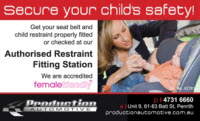Authorised Restraint Fitting Station
Restraint installation and Inspection Reports
Production Automotive is an RTA Authorised Restraint Fitting Station and are able to offer the following services: - Inspect and adjust your child restraint to ensure it is installed correctly
- Correctly fit and install a child restraint.
- Provide Restraint Installation and Inspection Reports (carried in the vehicle for presentation when requested by an authorised officer of the RTA or police).
Why professional restraint installation?
It is estimated that every year in Australia, 28 children aged 10 years and under are killed and 2773 are injured in car crashes*.These statistics are heartbreaking – particularly as some of these fatalities and injuries could be prevented or reduced if all children occupy the right restraint for their size and age, and if the restraint is installed and used correctly.
New child restraint laws were introduced in March 2010 to reduce these statistics (click here for the RTA's Guide to buying child restraints). These laws specify that all children up to the age of seven must now be fastened into the correct restraint for their age and size. As an Authorised Restraint fitting Station, we are aware of how vital it is to have the restraint correctly fitted.
What do the new laws mean to parents?
The national laws state that:
- Babies up to six months of age must be secured in a rearward facing restraint
- Children from six months to under four years of age must be secured in either a rearward facing or forward facing restraint, and
- Children between four and seven years of age must be secured in a forward-facing restraint or booster seat.
Interestingly, fitters recommend that children be kept rearward facing for as long as possible due to their body mass being absorbed into the surface area of the seat on impact, rather than simply being restrained by a seatbelt.
It’s also important to use your judgment and remember that the ages recommended by the RTA are a guide only - the laws state that if your child is too small for the restraint specified for their age, they should be kept in their current restraint for as long as necessary. The same is true if your child is too large for the restraint specified for their age - they may move to the next level of restraint.
Simple tips
Here are a few simple tips for providing the best protection for your child in a motor vehicle:
- Always choose the restraint most appropriate to your child’s age and size – don’t buy one thinking that they will ‘grow into it’
- Use a restraint which has been approved to the Australian standard – it should display a sticker with a red tick. The Australian standard is one of the toughest child restraint standards in the world
- Never purchase a restrain from overseas – they don’t comply with Australian Standards and aren’t compatible with Australian vehicles
- Only use second-hand restraints when you are getting the restraint from someone you know well – this is because it may be difficult to accurately confirm its history. It is vital that it has not been involved in an accident - never use it if it has been involved in a crash or if there are obvious signs of wear or deterioration on any part of the restraint (such as worn straps, bent or worn buckles, or the attachment points in the plastic shell are cracked or discoloured from age, overloading or exposure to the sun). You also need to ensure that the red Australian Standards sticker with the tick is intact
- Don’t use a restraint older than ten years of age
- Ensure that you have your restraint installed or checked by an Approved Restraint Fitting Station
- Always use the centre rear seat position as a first preference for fitting your restraint
- Be aware that in NSW it is illegal to use a child restraint in the front passenger seat of a vehicle if airbags are fitted. You should always ensure children are travelling in the rear of the vehicle for increased safety
- Trust your instinct and don’t move your child to the next restraint before they are ready (restraints that are designed for larger or older children increases the risk of serious injury in an accident), and
- Always refer to the manufacturer’s instruction – if in doubt, ask a professional!
While the police issue fines and demerit points to drivers who fail to ensure all children are appropriately restrained - $253 and three demerit points for each unrestrained or incorrectly restrained child - the real incentive is knowing that a child that is properly secured in an approved child restraint is less likely to be injured or killed in a car crash than one who is not.
As parents it is not only our responsibility to choose a restraint that offers the highest level of protection, but also to ensure that it is installed and used correctly. If you are ever in doubt, give yourself peace of mind and consult a professional!
To have your restraint correctly fit and a Restraint Installation and Inspection Report issued, or to ensure the installation of your restraint is correct, call us for an appointment!
*National Transport Commission, Australian Road Rules, 7th Amendment
Package 2007, Regulatory Impact Statement.
